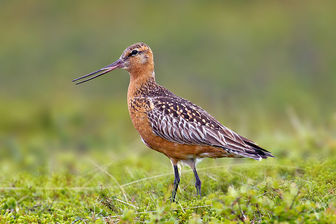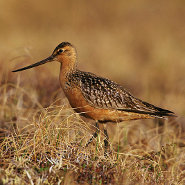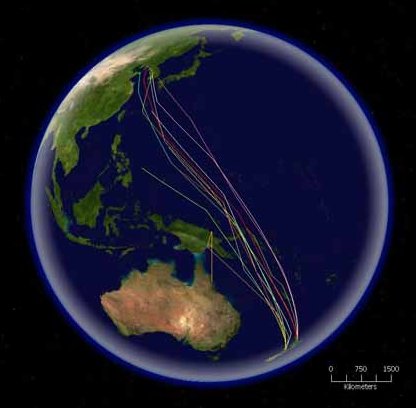Bar-tailed Godwit
The Bar-tailed Godwit is a relatively short-legged species of godwit. The bill-to-tail length is 37–41 cm, with a wingspan of 70–80 cm. Males average smaller than females but with much overlap; males weigh 190–400 g, while females weigh 260–630 g; there is also some regional variation in size . The adult has blue-grey legs and a very long dark bill with a slight upward curve and pink at the tip. The neck, breast and belly are unbroken brick red in breeding plumage, off white in winter. The back is mottled grey.

Original source: Own work
Author: Andreas TreptePermission(Reusing this file)This photo was taken by Andreas Trepte.Please credit this photo Andreas Trepte, www.photo-natur.de.
The Bar-tailed Godwit - Winged Marathoners
 The bar-tailed godwit (limosa lapponica) is a wading bird with a long bill and long legs. It gets its name from the striped ("barred") markings on its tail feathers, which distinguishes the bird in appearance from the black-tailed godwit and other relatives.
The bar-tailed godwit (limosa lapponica) is a wading bird with a long bill and long legs. It gets its name from the striped ("barred") markings on its tail feathers, which distinguishes the bird in appearance from the black-tailed godwit and other relatives.
The size of the bar-tailed godwit differs by sub-species, but on average, the birds are between 35-40 cm (13-16 inches) from bill to tale, with an average wingspan of around 75 cm (30 inches). The male of the species is smaller, weighing, on average, around 300g (just over 10.5 ounces). The female averages 370 grams, or around 13 ounces. The weights of both sexes, however, varies widely, depending on the time of year and geographic location.
While the bar-tailed godwit is found on all continents, primarily along the coasts, it is known to breed in parts of Asia and Alaska. The birds generally live in coastal habitats, such as marshes, sand flats, mudflats, estuaries, and inlets. When breeding, however, they prefer areas of lowland rolling tundra. Bar-tailed godwits feed primarily on insects, mollusks, and crustaceans.
Above all, bar-tailed godwits are known for their exceptional migratory patterns. These birds fly the length of the Pacific semi-annually. In early spring, they depart from Australia or New Zealand, heading directly to East Asia, where they stop to fatten up for a few weeks. Then, the birds fly the remainder to Alaska without pause. Each winter, the bar-tailed godwits return, flying the 6,800+ miles down the Pacific nonstop, making theirs the longest known non-stop migration flight.
To date, zoologists are uncertain why the bar-tailed godwit takes this route rather than a more friendly flight pattern over Asia, which would allow the birds to feed with regularity. Over time, however, the birds have evolved in order to be able to fly these incredible distances without stopping for food. They have small stomachs, which have been replaced by muscle and fat that is burned during flight.
At the present time, the conservation status of the bar-tailed godwit is unclear. The International Union for Conservation of Nature and Natural Resources rates the species as being of "lowest concern." The U.S. Shorebird Conservation Plan, however, has categorized the bird as a "Species of High Concern," in part, perhaps, based on the limited breeding grounds for them in the United States. While most of the threat to the bar-tailed godwit population comes from loss of habitat and expansion of industry, they also face encounters with predatory birds such as ravens and gulls.

The routes of satellite tagged Bar-tailed Godwits migrating north from New Zealand
Bar-tailed Godwits undertake the longest non-stop flight of any bird.
The Bar-tailed Godwit is classified as Least Concern. Does not qualify for a more at risk category. Widespread and abundant taxa are included in this category.

Permission: Some rights reserved
Family : Scolopacidae
Genus : Limosa
Species : lapponica
Authority : (Linnaeus, 1758)
